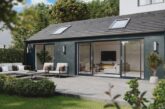
Quickslide’s Adrian Barraclough on the doors that get the biggest bang for your customer’s buck.
Adding a bright new front door can make a huge difference to how a home looks and performs, and for very little money. So if you’re talking to a customer abut building an extension, and especially a front porch, having some knowledge about the options available for decent resi doors will significantly enhance your God-like status in their eyes and actually, add a bit of extra margin too.
So what’s out there at the moment? Well, of course, you can go down to your usual merchants and buy something timber off the racks. But if you turn to your regular trade window and door fabricator then you have a whole lot of choice when it comes to what are known as composite doors. These do a very good job of (usually) looking like a quality timber door, but which is actually a couple of glass fibre (and now even aluminium) skins sandwiching a core produced using a variety of materials including a solid PU foam, or other materials such as timber (as in the case of the doors we supply, by Solidor, which also have skins made using the same material as Lego!).
Crucially, composite doors will outperform traditional timber doors in pretty much every way including security, insulation, durability, maintenance and often, looks too, as most suppliers will now offer a huge range of colours and finishes. These include matt and high gloss painted woodgrains (produced by making a mould from a genuine timber door), in addition to other smooth ‘skins’ that, ironically, are intended to complement the huge market interest in aluminium frames that is sweeping the market currently.
Prices too are also incredibly varied. In fact, composite residential doors are now increasingly offered as an upmarket and even luxury addition to a property and indeed, retail prices can vary from around £1,000 fitted, to anything up to £10,000 – although we are getting into professional footballer territory at that end for doors that would look a tad out of place in a three bed semi. Trade prices will take 50 per cent or so off of that depending upon terms.
Ironically, however, composite doors actually began life around 20 years ago as a solution for social housing, a market that still fits them in the tens of thousands. They are tough, secure, thermally efficient and cheap as chips too, though the finishes, fixtures and fittings are also a lot cheaper than those offered for private sale. But essentially they are the same thing.
But let’s get back to what you can offer your customers…First of all, buying cheap will inevitably be a false economy and one that will see you called back to sort out the typical cheap door issues such as discoloration, delamination of the skins from the core, and probably the most frequent problem, hardware failure. The latter should be covered by ensuring that the doors you choose are PAS24:2016 approved, which makes them especially appropriate for new builds.
And everything else will be dealt with by buying from a good supplier. OK you have heard that before and especially from me…but you know it is true. And do you really want to risk the relationship with your customer?
The upshot is that by learning a little about composite doors you can offer your customer advice that will lead to them spending a relatively small amount of money for a disproportionately significant effect not only on the appearance of their house but also, on the way it ‘feels’. Because of the frequency with which the front door is used, the smooth and secure way a lock operates on a new door, combined with the weight of the leaf itself, will give reassurance to the homeowner as well as being great to look at.
So much so that maybe you should sell them a back door as well!
![]()







